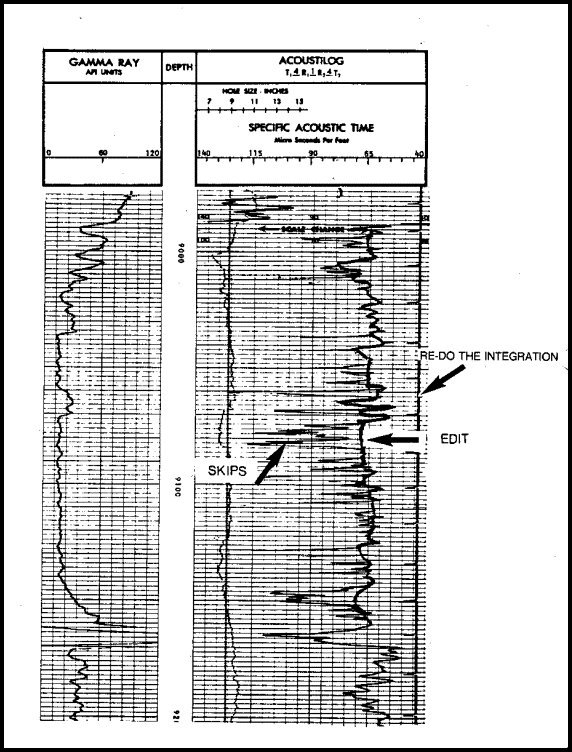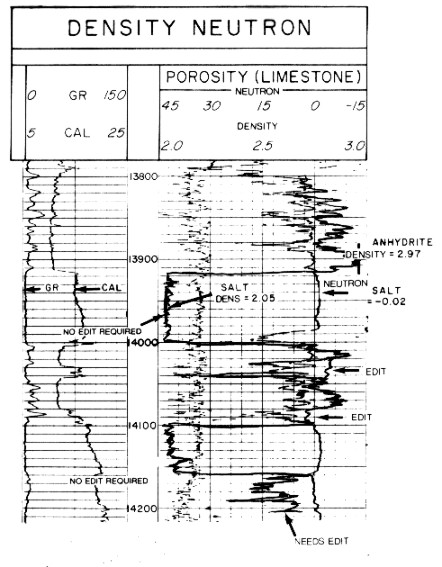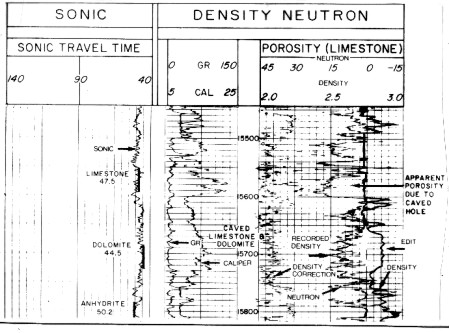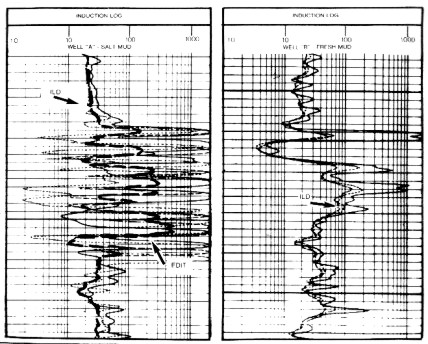|
 BASIC Log Editing
Concepts
BASIC Log Editing
Concepts
This
Chapter examines why editing is needed, how to do it, and
illustrates some examples. It is not unethical to edit,
correct, repair, or otherwise modify a log, if corrections
are needed and made properly. Keep a record and include it
in the final report. Some people are horrified by the
concept of modifying logs arbitrarily, preferring instead to
believe either the service company can never be wrong or
that bad data should not be used. This attitude results in
errors in analysis results or wasted data.
There are two major facets of log editing:
1. recognize bad data,
2. substitute better data.
Sounds easy! But most of us underestimate the severity of the
problem. Bad data can be easily recognized in cases of obvious
noise, such as cycle skips on the sonic log or hole washouts. It may be difficult in subtle hole condition
changes, different lithologies, borehole weathering, and
undetected or unrecorded log calibration problems.

Sonic log before and after edit
If
logs were perfect, editing would not be required. However, logs
can suffer from a number of problems, such as:
1. misidentification of curves or scales
2. miscalibration
3. electronic failure
4. human failure
5. noise
6. depth discrepancies
7. poor borehole conditions
8. improper tool choice for the hole conditions
9. environmental effects such as temperature, mud salinity, mud
type, mud weight
10. bed boundary and bed thickness effects
11. deviated boreholes
Good
judgment, interpretation, and background data from offset wells
are needed in order to substitute better data.
If a
log cannot be repaired, note this fact and consider your task
complete - don't use the data if it isn't any good.
Logical use of other log curves in the well, or in offset wells,
plus regional trend data prepared in advance by the analyst,
will be the basis for most edits.
On
older sonic logs, the worst cases are caused by cycle skipping,
which results from a large rough borehole, a poor logging tool,
a sleepy logging engineer, gas in the borehole, or gas in the
formation. On uncompensated logs, spikes caused by hole size
changes must be removed. On modern array or full wave sonic
logs, missing data due to low amplitude signals must be
interpolated.

Example of a sonic log that requires editing before use in
either a petrophysical analysis
or a seismic modeling study
Rock
alteration due to drilling affects both the sonic and density
logs. If regional trends
for sonic and density data are known for each major lithology
(shale, sand, carbonates), these can be used to draw a more
reasonable log.

Sonic and density edited for rock alteration
On
density logs, the worst cases are caused by large or rough
borehole, which often occurs in shale sections, in stress
relieved carbonates, and in gas bearing formations. An example
of a reconstructed density log, corrected for bad hole and rock
alteration is shown above.

Sonic and density editing based on lithology
and trend analysis
It
is sometimes difficult to discriminate coal and salt beds from
rough hole effects (they often go together), so recourse must be
made to other logs or sample descriptions. Needless to say, no
two analysts will do exactly the same job of editing. An example
of salt interbedded in carbonates and evaporites is shown below. Although, the logs show great activity and the
caliper shows a large hole, the log readings are valid and
consistent with the lithology descriptions. No edits are needed.

Salt beds look initially like bad density log
- neutron and GR give clues
Contrast this example with the log shown below, in which the density
log is badly affected by large and rugged hole conditions. An
edit is definitely needed here. Although the sonic log is a bit
noisy, it really doesn't need any editing.

Genuine bad hole condition affecting density -
sonic and caliper are clues
Even
resistivity logs may need edits. The illustration below shows a noisy
induction log, run in a salt mud by mistake, compared to one
from a nearby well in fresh mud. Since resistivity logs are used
to edit sonic logs, it pays to be sure that they are valid
before using them for this purpose.

Induction log affected by salt mud (left).
fresh mud case (right - don't use a bad log as a
guide to
editing another bad log
When
in doubt, we feel that the more severe editing should be done
first, and adjustments towards leniency be made after the first
few response computations have been reviewed. Integrated time
discrepancies are the most obvious clues to over edited or under
edited data, and usually the offending zone can be identified
readily, when compared to seismic section character, check shot
data, or VSP data.
It
is not unethical to edit, correct, repair, or otherwise modify a
log, if corrections are needed and made properly. Some people
are horrified by the concept of modifying logs arbitrarily,
preferring to believe either the service company can never be
wrong or that bad data should not be used. This attitude results
in interpretation errors or wasted data.
The
watchword in editing is CAUTION ! Try to edit the garbage, but
leave in all legitimate anomalies.
|

